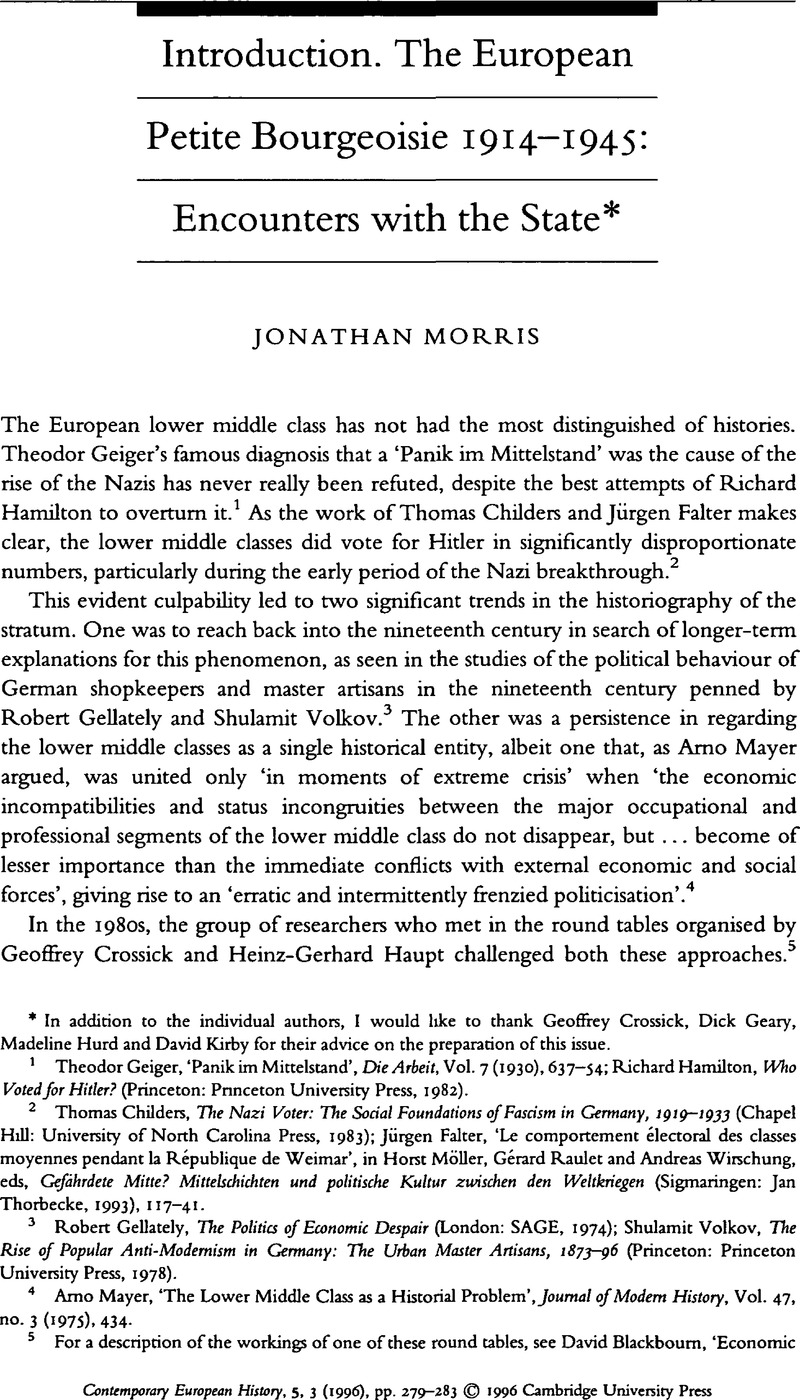No CrossRef data available.
Published online by Cambridge University Press: 12 September 2008

1 Geiger, Theodor, ‘Panik im Mittelstand’, Die Arbeit, Vol. 7 (1930), 637–54Google Scholar; Hamilton, Richard, Who Voted for Hitler? (Princeton: Princeton University Press, 1982).CrossRefGoogle Scholar
2 Childers, Thomas, The Nazi Voter: The Social Foundations of Fascism in Germany, 1919–1933 (Chapel Hill: University of North Carolina Press, 1983)Google Scholar; Falter, Jürgen, ‘Le comportement électoral des classes moyennes pendant la République de Weimar’, in Möller, Horst, Raulet, Gérard and Wirschung, Andreas, eds, Gefährdete Mitte? Mittelschichten und politische Kultur zwischen den Weltkriegen (Sigmaringen: Jan Thorbecke, 1993), 117–41.Google Scholar
3 Gellately, Robert, The Politics of Economic Despair (London: SAGE, 1974)Google Scholar; Volkov, Shulamit, The Rise of Popular Anti-Modernism in Germany: The Urban Master Artisans, 1873–96 (Princeton: Princeton University Press, 1978).Google Scholar
4 Mayer, Arno, ‘The Lower Middle Class as a Historial Problem’, Journal of Modern History, Vol. 47, no. 3 (1975), 434.CrossRefGoogle Scholar
5 For a description of the workings of one of these round tables, see Blackboum, David, ‘Economic Crisis and the Petite Bourgeoisie in Europe during the 19th and 20th Centuries’, Social History, Vol. 10, no. 1, (1985), 95–104.Google Scholar
6 Crossick, Geoffrey and Haupt, Heinz-Gerhard, ‘Shopkeepers, Master Artisans and the Historian: The Petite Bourgeoisie in Comparative Focus’, in Crossick, Geoffrey and Haupt, Heinz-Gerhard, eds, Shopkeepers and Master Artisans in Nineteenth Century Europe (London: Methuen, 1984), 3–31.Google Scholar
7 Blackbourn, David, ‘Between Resignation and Volatility: The German Petite Bourgeoisie in the Nineteenth Century’, in Crossick, , Haupt, , Shopkeepers and Master Artisans, 35–61Google Scholar; Nord, Philip, Paris Shopkeepers and the Politics of Resentment (Princeton: Princeton University Press, 1986).Google Scholar
8 Koshar, Rudy, ‘On the Politics of the Splintered Classes, in Koshar, Rudy, ed., Splintered Classes. Politics and the Lower Middle Classes in Interwar Europe (New York: Holmes and Meier, 1990), 15–16.Google Scholar
9 Marx, Karl and Engels, Friedrich, The Communist Manifesto (London: Penguin, 1967), 88.Google Scholar
10 Marx and Engels, Communist Manifesto, 91; Crossick, Haupt, ‘Shopkeepers, Master Artisans and the Historian’, 26n.
11 Bechhofer, Frank and Elliot, Brian, ‘Petty Property: The Survival of a Moral Economy’, in Bechhofer, Frank and Elliot, Brian, eds, The Petite Bourgeoisie. Comparative Studies of the Uneasy Stratum (Basingstoke: Macmillan, 1981), 183;Google Scholar see also idem, ‘Persistence and Change: The Petite Bourgeoisie in Industrial Society’, Archives européennes de sociologie, Vol. 17, no. 1 (1976), 76–9; Crossick, Haupt, ‘Shopkeepers, Master Artisans and the Historian’, 6–10.
12 Idem, The Petite Bourgeoisie in Europe 1780–1914 (London: Routledge, 1995), 4.
13 Kocka, Jürgen, Facing Total War. German Society 1914–1918 (Leamington Spa: Berg, 1984), 77–113Google Scholar; Lyth, Peter J., Inflation and the Merchant Economy. The Hamburg Mittelstand, 1914–1924 (Oxford: Berg, 1990).Google Scholar